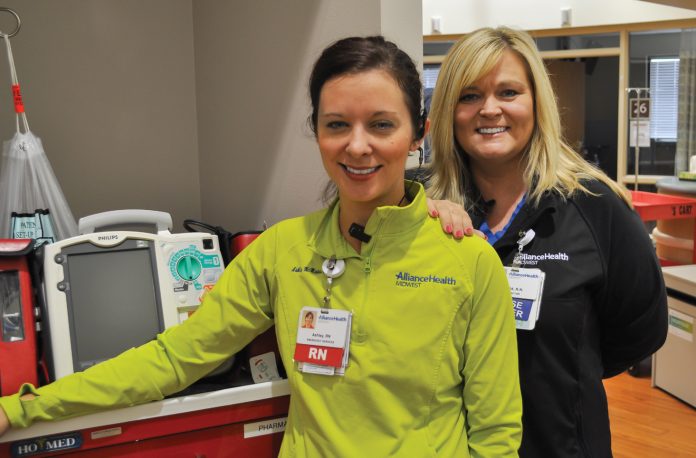
by Bobby Anderson, Staff Writer
In November, months of preparation and hard work will be put to the test at AllianceHealth Midwest.
Surveyors from The Joint Commission were set to arrive on campus to decide whether or not the hospital was deserving of national stroke certification.
The visit would be the culmination of months of planning, protocols and streamlining by Emergency Department Director Tesha Loven and her staff.
Stroke classes for system nurses began in late September. Loven’s’ staff took ownership to educate the inpatient staff.
“We’re excited because it’s not just about the ER. Now it’s about the whole hospital getting on board and having that same goal and mission of taking care of the stroke patient,” Loven said.
The stroke program requirements were developed in collaboration with the American Heart Association/American Stroke Association (AHA/ASA).
Applicants for advanced certification must meet the requirements for Disease-Specific Care Certification plus additional, clinically specific requirements and expectations.
“It’s very important to us as a hospital as well as for the community,” Loven said. “It’s about expanding the services we are providing.”
The minutes following signs and symptoms following a stroke are critical. Clot-busting agents can only be administered during the golden hour following a stroke.
“We want to make sure we have that service here and can provide that in our community so they don’t have to drive that extra time to another facility,” Loven said. “That delays (care) and there’s a potential they can’t have it.”
“It’s basically for the betterment of our community. It’s more of a trust-factor for our community.”
Loven said ER nurse Ashley McMains, RN, BSN was instrumental in the process.
“Ashley took ownership in the beginning. She identified where we really needed education and she was excited certification was one of our goals,” Loven said. “Even before the certification we were already headed in the direction of consistent processes to meet the patient care standards.”
“Really, Ashley was the one who put all that into place.”
McMains also balanced nurse practitioner school through the whole process. She was able to view the process through advanced practice eyes.
“I think it’s very important because stroke symptoms can be very vague,” McMains said. “It’s taken a lot of education for the staff to think ‘could this be related to a neurological thing or could it be musculoskeletal.”
“There’s obvious things I think everybody has thought about but some things like dizziness or numbness of the face I don’t think a lot of the nurses would have gone down that route before us going through this process. It’s definitely taken a lot of education.”
McMains actually came from a stroke center two years ago.
Joining Loven’s team she noticed the focus on possible strokes just wasn’t the same.
She voiced that frustration to Loven who challenged her to help bring about change. Pursuing national stroke certification through The Joint Commission began not long after.
“It’s exciting because I’m seeing a change in a lot of the doctors and a lot of staff as well,” McMains said. “They’re seeing the urgency.”
For years, AllianceHealth Midwest has been able to administer thrombolytics to stroke patients who meet criteria. Loven views the certification as just further validation AllianceHealth is meeting and exceeding national standards throughout its continuum of care.
“Really, I think going through the certification we are able to provide care a lot better because it requires a lot of education for the staff and there are certain times that have to be met for national benchmarks,” McMains said. “When she says we were providing it before we were just not as efficient.”
The process required buy-in from all departments.
“The staff are really excited because it’s just one more thing that we are able to do for the community,” Loven said. “We just got the open-heart program back and that’s been exciting for the hospital because you want to go somewhere that you can work that you can always move up.”
“We’re providing that next step, that next opportunity. Our goal is to get where we are accredited in all the services.”
The emphasis on stroke protocols has already made a difference. Loven said before the process the hospital would see one to two thrombolytic interventions per quarter.
“Now we’re seeing one to two about every other week,” Loven said. “It’s because we’re identifying it so much quicker. When the patient gets here we’re following a consistent process.”
“We run every single patient through a Code Stroke if they have a symptom regardless of time of onset. The fact that we’re looking for the needle in the haystack we’re providing more TPA for the appropriate patients because of the processes and education we’ve put in place.”

Small but BIG.
Small enough to care about you,
big enough to care for you!
We are hiring!
· Clinical Educator – Master’s in nursing and critical care experience required
· PACU RN’s
· Emergency RN’s
· Med/Surg RN’s
· ICU/CCU RN’s
· Telemetry RN’s
· Surgery RN’s
· Psych RN’s
We’re interviewing December RN graduates for our new grad nurse program!
www.alliancehealthmidwest.com
EOE











